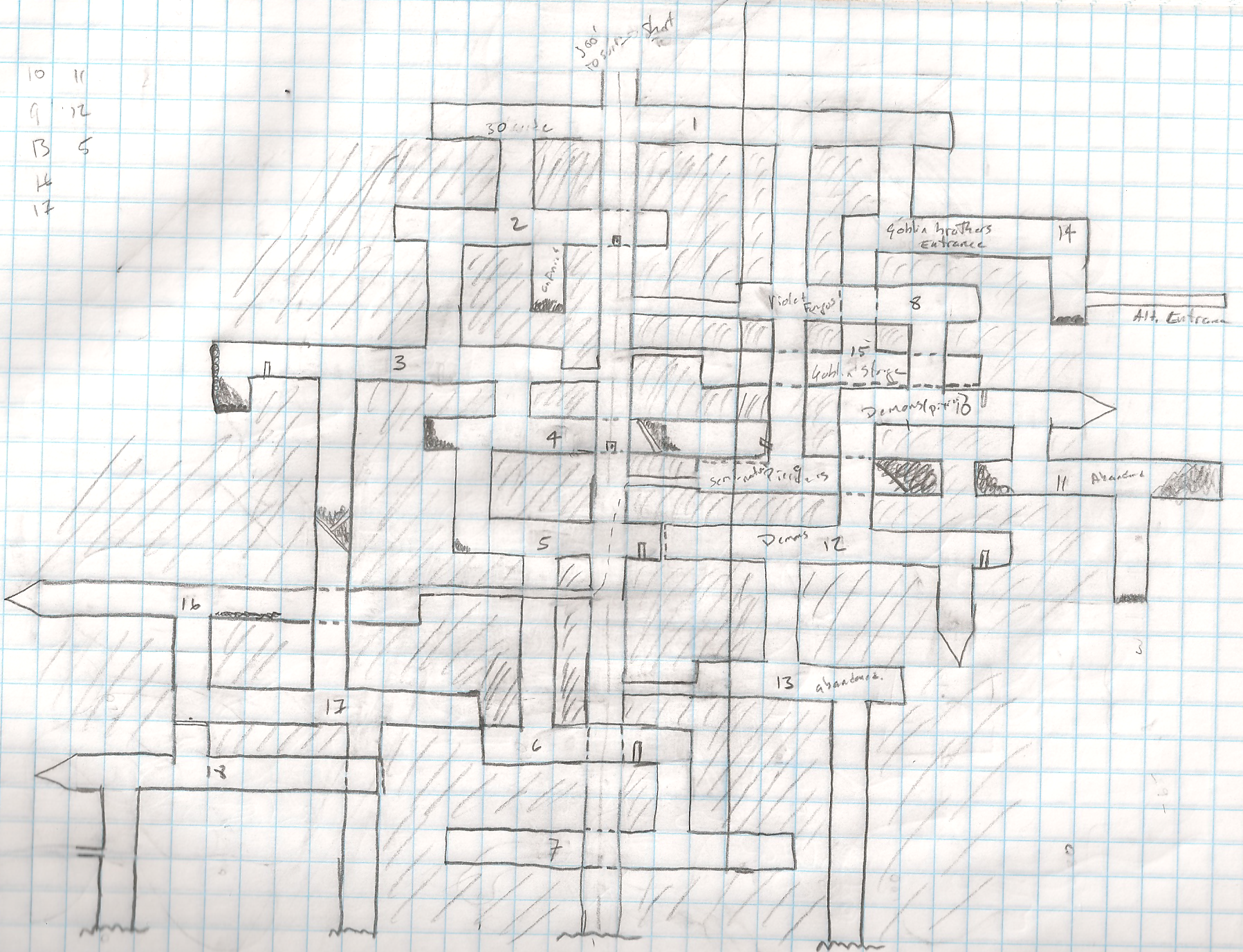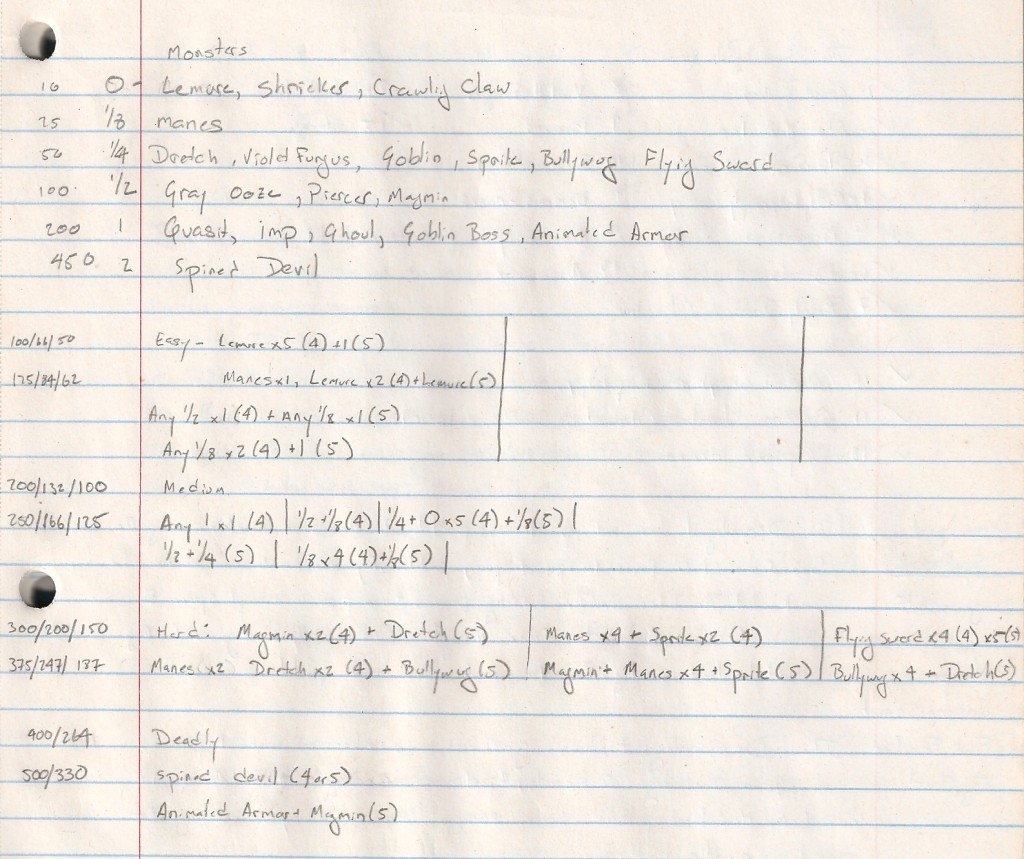Dungoneering: A Mineshaft
As my brother has been relating, I’ve taken my party down into a silver mine outside the town of Metarius, just east of the City of Parminium, in western Killbar. This means nothing to most of you, but thats alright. Today I’m not going on about my world, but about how I went about building a dungeon. I want to talk about Parminium, Killbar, ect, but I have to wait until each of those parts pan out and are explained to the players before I get really into it.
The mine, However, is completely finished. I won’t go into how that panned out, as my brother will do that just fine, but the creation of a dungeon is a difficult thing, so I figured I’d dip in that direction.
What good is it going to do, though, without a map!
To be fair, this is a pretty complex map, something I’d decided on when I read a bit on how Roman Silver mines were dug, as this culture is based, loosely, on Rome.
I didn’t spend a ton of time doing painstaking research, but I did enough to know a bit more about what I was talking about, and get a feel for what I would be describing, and using the right verbage. Making sure you use the right words makes a ton of difference when your trying to convince your players they are in something different.
If I said area 2 was “a room 80 feet across, with two holes in the floor” that gives a very different feel than “This Gallery opens up and runs 80 feet end to end. All the surfaces are uneaven, and the ceiling is held up by four foot diameter solid stone colums that extend naturally from the floor to the ceiling. The walls and the rest of the ceiling are held up by large, slimy timbers. Two more mine shafts continue downward, out of sight.”
Rooms are called galleries, downward tunnels are called shafts. The water table was always a problem, so I made this abandoned mine part of a large hill in order to make it adventure able without having flooded. Some of the rooms have collapsed, and the bottom of the area is flooded.
I dug into the technique or Roman Mining, and I found a few pretty interesting things. First, that they would follow a single, small shaft down fairly deep, and that they would dig out whole rooms piece at a time in what are called galleries. They then would follow the veins down and create more galleries and more shafts until they finished. They would also want a way to carry out the debris, so most places would have a quick way to get that rubble to the main shaft where it could be winched up in buckets. I figured that, and I could be completely wrong, precious metals would almost flow like a river, with branches and tributaries, and this being a hill it would almost look like a volcano.
So, I dug the main shaft, that from which all other veins would flow. Then, almost randomly, I built galleries and shafts. Some would be exceedingly long (see the shaft between 3 and 17) and some would be exceedingly short (Between 3 and 4). I then added the shafts connecting the galleries to the main shaft, and then built a pair of quick exits that the inhabitants had made while living there. I also knew that this mine wasn’t tapped out and abandoned because it wasn’t producing, so I made a few of the galleries taper off into unfinished work.
Next, I looked at the area and collapsed some passages and walls, and tried to make sure that nothing I’d built was trapped off from the rest, too badly. Not designing what people don’t see is difficult for me, but whats going to be behind collapsed walls and shafts in a mine at level 1? Probably nothing.
With portions collapsed, I numbered the Galleries so I have an idea how many I had and what I could do with them. While I was doing this, I noticed that there was a pair of galleries tucked away from all of the rest (14 and 15). I knew I wanted my demonologist to be hidden away, but that didn’t make any sense to be close to the top, so I figured I’d just keep it in my back pocked.
Speaking of demonology. Early on I decided I wanted to take this a little bit of a different direction than most of the adventures I’d run at first level. Many times I had brave adventurers fight Kobolds, Lizardmen, or goblins. This time, I wanted something a bit different. I took a peruse through the Monster Manual and found the Manes, the souls of those foul enough to be taken to the abyss and given form.

From there it was easy to grab Lemures, Quasits, Imps, and Dretch. I took a few other creatures as well and made them look demony, and we had our menagerie. I wasn’t quite as happy as I wanted, so I kept looking and found some low level fungus! I’d never used before and then I was happy.
I took a look again at my galleries, and I started re-numbering them. Having a plan for these rooms makes my life easier, so I numbered them in groups.
One of the easiest trails would be off to the left of the page. That ended up being grouping 1-7 that group is pretty linear. I expected at that point they’d go back up to the top and start down the second shaft, hence grouping 8-13. I’d decided to include a nod to goblins, though, but they kept to themselves: Rooms 14 and 15. Finally, the Demonologist himself needed a place to be in the middle of his nefarious plans, so he went in rooms 16-18
That was it! that was all that was, originally on this map. I did some work on encounter sizes and stared building some encounters that I could pull from when and how I wanted. Seeing as I would have the possibility of either 4 or 5 players, I made an encounter chart with level 4 fights, and then what I’d need to add to make it level five.
After that, I made simple, one-two word descriptions of the rooms, in an extremely basic format:
1: Grand Gallery 8: Violet Fungus 14: Goblin Home
2:Shrieker Den 9: Piercers 15: Goblin Storage
3:Lemures 10: Demon (Arrow)
4: Collapsed/Empty 11: Demon (Manes)
5: Demons 12: Demons
6: Demons 13:Abandoned
7:Empty – Flooded
16:Quaist or Imp Spy
17:Guardian Chamber – Animated Sword and Armor
18: Spined Demon
While a lot of that changed during gameplay to make for a better story, I did give me a basic stage with which to set up everything. Because it was simple, basic phrases, even when I forgot my notebook at home one day, which is how the words became written on the map) I was able to get the basic gist of the information to work.
Finally, I knew I wanted to have The demonologist having discovered a way to use the still living blood and bodies of his vicitms to make small, weak portals to the Iron Marches (My Outer Planes). I knew I wanted them to be built from the still living bodies of his victims, kept alive by healing magics and the power of the portals themselves, but I didn’t know how I was going to pull it off.
Thats where running the dungeon came in, and you can read how the adventure progressed with my brothers overviews! Honestly this is extremely close to how I work out all of my dungeons, though each one has its own take. This one was a couple of basic concepts thrown together to try and make something a little different from your standard first level fare.
I wanted the to have their first “reclamation” not be an item, but a place. Turn the idea a little sideways.
I’d never done an adventure in a mine.
I’d never used demons in a level 1 adventure.
That’s it! something as simple and easy as three concepts tossed together to make a crazy, dangerous, and hostile environment for the PCs to traverse!

